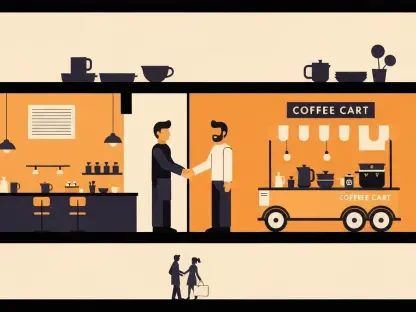The restaurant industry is witnessing a profound transformation driven by the burgeoning influence of food delivery platforms like DoorDash, Uber Eats, Grubhub, and Seamless. Initially emerging as convenient supplements to traditional dining, these digital services have significantly altered how individuals select and enjoy meals. By allowing consumers to order their preferred dishes effortlessly through their smartphones, these platforms have not only created a new dining culture but have also introduced novel challenges and opportunities for restaurants. As these services gain traction, they exert pressure on profit margins and intensify competition, reshaping the entire landscape of the industry.
Evolution of Consumer Behavior
The rise of food delivery apps has fundamentally altered consumer dining habits, offering individuals the chance to explore a wide array of dining choices beyond their immediate locality. Utilizing advanced smartphone integration, these apps provide users with conveniences such as GPS functionalities and real-time delivery updates, revolutionizing the way people engage with food services. With the simple tap of a screen, consumers can taste culinary creations from a vast selection of eateries without concern for distance. By negating geographical constraints, these apps foster an environment where diners prioritize convenience and broader options over traditional dining experiences. This change has also led to shifts in personal lifestyles, as consumers increasingly blend professional and personal commitments with seamless dining solutions.
Such apps not only accommodate busy schedules but also introduce people to a diverse culinary world, fueling new dining preferences. While participation in nightly takeout has become more common, so too has experimentation with different cuisines and flavors. This evolution in dining habits prompts consumers to form relationships with restaurants based on accessibility and novelty rather than physical proximity or reputation. By promoting dynamic engagement, food delivery platforms nurture customer curiosity and loyalty, encouraging repeat patronage alongside exploratory dining adventures. As these experiences become routine, restaurants must adapt their offerings and operations to meet evolving consumer expectations, emphasizing quality and efficiency alongside creativity.
Intensified Competition Among Restaurants
The advent of delivery platforms has ushered in a new era of competition within the restaurant industry, compelling establishments to broaden their competitive scope. No longer confined by geographical limitations, restaurants face a two-pronged competition: horizontal, against a wider range of eateries, and vertical, imposed by the charges of delivery apps. These platforms charge substantial fees, including commissions that can run between 15% and 30% per order, coupled with additional delivery and payment processing costs. This fee structure significantly erodes profit margins and challenges the financial viability of many establishments, particularly smaller or less efficient ones.
In such a competitive landscape, restaurants are compelled to innovate and refine their offerings to maintain consumer interest. They must focus not only on providing exceptional food quality but also on optimizing their operational efficiency to absorb the costs imposed by delivery platforms. The ability to deliver consistent and high-quality experiences in the face of such financial pressure becomes a differentiating factor. Furthermore, restaurants must keep pace with market trends and consumer preferences by offering unique menu options that entice an increasingly discerning clientele. As consumer loyalty can be fleeting, the emphasis on quality and novelty becomes more crucial for survival and growth. This dynamic compels restaurants to build distinct brand identities that resonate with their target audiences.
Impact on Restaurant Viability
Research reflecting on the period from 2012 to 2018 highlights a concerning trend regarding the increased likelihood of restaurant closures influenced by digital platform pressure. The studies underscore that the competitive environment, coupled with heightened operational costs, places a significant burden on restaurant survival. New, smaller restaurants that have yet to establish a strong consumer base or demonstrate operational excellence are particularly vulnerable to these challenges. Without substantial brand recognition or a loyal customer following, such establishments face acute difficulties competing within this platform-driven model.
Moreover, the heightened pressures and operational costs can lead to compromised service quality, further diminishing a restaurant’s appeal and sustainability. In this context, efficiency in operation and the capacity to manage resources effectively become pivotal for restaurant viability. Establishments that fail to innovate or adapt quickly to the changing environment often find themselves at risk of closure. As the restaurant industry continues to navigate this evolving landscape, success is increasingly tied to the ability to reduce operational inefficiencies, adapt to consumer demands, and establish a recognizable brand that inspires trust and preference. The survival of restaurants under such stringent conditions demands a strategic reevaluation of traditional business models and a commitment to resilience.
Potential Beneficiaries in the Hospitality Sector
Amidst the challenges confronting the restaurant industry, certain hospitality segments, particularly bars and clubs, may stand to benefit from the integration of delivery platforms. Unlike traditional restaurants, these venues have the opportunity to complement the services offered by delivery platforms rather than suffer direct competition. Individuals often prefer to order takeout before engaging in nightlife activities, aligning consumer behaviors in a manner that fosters mutually beneficial relationships. By tapping into the convenience offered by delivery apps, these establishments can expand their reach and augment their revenue streams.
These complementary dynamics present bars and clubs with alternative growth opportunities, where delivery services act as an avenue for enhancing their core offerings without direct conflict. As patrons increasingly seek diverse and memorable experiences, these venues can leverage delivery apps to introduce patrons to unique food and beverage pairings, thus enhancing their overall appeal. By capitalizing on the symbiotic relationship between delivery services and nightlife experiences, these establishments stand to strengthen their patronage and brand presence in the market. Furthermore, these beneficial interactions demonstrate how certain sectors within the hospitality industry can maintain relevance and prosperity amid the prevailing trends of platform-driven consumer engagement.
Shifting Success Factors in the Industry
The restaurant industry is undergoing a significant shift due to the rising impact of food delivery platforms such as DoorDash, Uber Eats, Grubhub, and Seamless. Initially seen as convenient additions to traditional dining experiences, these digital services have revolutionized how people choose and enjoy meals. Consumers can now effortlessly order their favorite dishes using their smartphones, redefining dining norms and introducing a set of new opportunities and challenges for restaurants. As these platforms become more popular, they drive competition to new levels and put pressure on profit margins. Restaurants are prompted to adapt to changing consumer behavior, often pivoting their business models to accommodate the increased demand for delivery. This transformation is reshaping the industry landscape, prompting establishments to innovate or risk being left behind. Whether enhancing operations or reimagining customer engagement, the restaurant sector continues to evolve alongside the digital dining trend.









